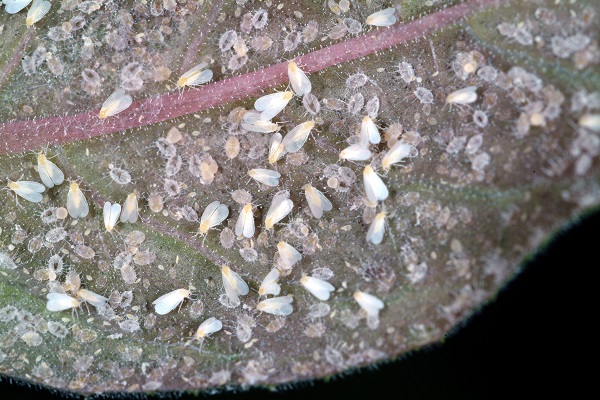Whiteflies in Gardens
ENTFACT-303: Whiteflies in Gardens | Download PDF
by Ric Bessin, Extension Specialist
University of Kentucky College of Agriculture
Whiteflies are small, 1/16 inch long, white, winged insects that suck sap from leaves of various plants including house plants, garden flowers, vegetables and weeds. The leaves of ingested plants may turn yellow, be twisted or stunted, wither and drop prematurely. Leaves also may be sticky with honeydew, a sugary solution excreted by the whiteflies. Sometimes a black fungus called sooty mold develops on the honeydew, and adds to the plant's problem by blocking out light and interfering with photosynthesis.
Whiteflies begin life as minute, virtually invisible eggs arranged in a semicircle on the underside of the leaves. These hatch into the crawler stage of the insect. Once the active crawlers settle down to feed they molt and become nymphs. Nymphs are stationary, light green, flat oval and with a fringe of short, white, waxy filaments radiating from the border of the body. Pupae develop from the nymphs and are similar in appearance, but have a few waxy filaments on their back.

Figure 1. Whiteflies can be common in greenhouses and high tunnels.
Adults emerge from the pupae, and in about four days begin laying eggs. All stages of development may occur at the same time on the plant.
When an infested plant is shaken or disturbed, the adults will flutter from the plant but quickly resettle. The entire life cycle takes about a month.
Whiteflies cannot overwinter outdoors at our latitude, but can continue from year to year in greenhouses, and in the far south. Whitefly problems in gardens in Kentucky usually begin from infested transplants. Houseplants and garden transplants should be examined carefully for signs of infestation before they are purchased. If you miss detecting infestations at the time of purchase, begin chemical control treatments in the garden as soon as you notice an infestation. Because insecticides are not effective against immature stages of whiteflies, applications need to be made every four days to kill adults before they begin to lay eggs for the next generation. Up to 7 applications may be needed to bring well-established infestations under control. Also, eliminate weeds in and around the garden that may harbor infestations.
Insect growth regulators (IGRs) that prevent whiteflies from molting correctly can provide effective control of whiteflies. Refer to the product label for permissibility of use on crops and directions for preparing spray solutions. For control of whiteflies on house plants, refer to ENTFact 406, "Houseplant Insect Control".
Common whitefly host plants include: Ageratum, Aster, Begonia, Calendula, Cantaloupe, Chrysanthemum, Cineraria, Coleus, Cucumber, Eggplant, Ferns, Fuschsia, Gardenia, Geranium, Gourds, Hibiscus, Lantana, Lettuce, Lupine, Mallow, Peas, Pepper, Petunia, Poinsettia, Potato, Primrose, Sage, Squash, and Tomato.
Revised: 11/19
CAUTION! Pesticide recommendations in this publication are registered for use in Kentucky, USA ONLY! The use of some products may not be legal in your state or country. Please check with your local county agent or regulatory official before using any pesticide mentioned in this publication.
Of course, ALWAYS READ AND FOLLOW LABEL DIRECTIONS FOR SAFE USE OF ANY PESTICIDE!
Photos courtesy Ric Bessin, University of Kentucky Entomology
